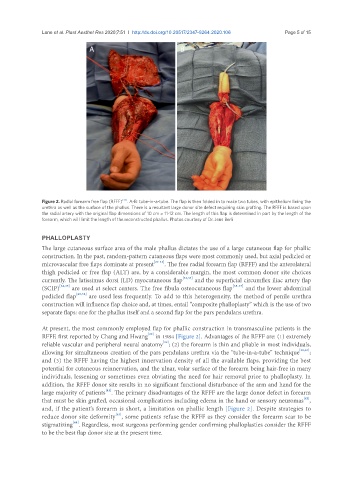Page 589 - Read Online
P. 589
Lane et al. Plast Aesthet Res 2020;7:51 I http://dx.doi.org/10.20517/2347-9264.2020.106 Page 5 of 15
A B
Figure 2. Radial forearm free flap (RFFF) [31] . A-B: tube-in-a-tube. The flap is then folded in to make two tubes, with epithelium lining the
urethra as well as the surface of the phallus. There is a resultant large donor site defect requiring skin grafting. The RFFF is based upon
the radial artery with the original flap dimensions of 10 cm × 11-12 cm. The length of this flap is determined in part by the length of the
forearm, which will limit the length of the reconstructed phallus. Photos courtesy of Dr. Jens Berli
PHALLOPLASTY
The large cutaneous surface area of the male phallus dictates the use of a large cutaneous flap for phallic
construction. In the past, random-pattern cutaneous flaps were most commonly used, but axial pedicled or
microvascular free flaps dominate at present [29-31] . The free radial forearm flap (RFFF) and the anterolateral
thigh pedicled or free flap (ALT) are, by a considerable margin, the most common donor site choices
currently. The latissimus dorsi (LD) myocutaneous flap [32,33] and the superficial circumflex iliac artery flap
(SCIP) [34,35] are used at select centers. The free fibula osteocutaneous flap [35-37] and the lower abdominal
pedicled flap [29,38] are used less frequently. To add to this heterogeneity, the method of penile urethra
construction will influence flap choice and, at times, entail “composite phalloplasty” which is the use of two
separate flaps: one for the phallus itself and a second flap for the pars pendulans urethra.
At present, the most commonly employed flap for phallic construction in transmasculine patients is the
[28]
RFFF, first reported by Chang and Hwang in 1984 [Figure 2]. Advantages of the RFFF are: (1) extremely
[39]
reliable vascular and peripheral neural anatomy ; (2) the forearm is thin and pliable in most individuals,
allowing for simultaneous creation of the pars pendulans urethra via the “tube-in-a-tube” technique [28,40] ;
and (3) the RFFF having the highest innervation density of all the available flaps, providing the best
potential for cutaneous reinnervation, and the ulnar, volar surface of the forearm being hair-free in many
individuals, lessening or sometimes even obviating the need for hair removal prior to phalloplasty. In
addition, the RFFF donor site results in no significant functional disturbance of the arm and hand for the
[41]
large majority of patients . The primary disadvantages of the RFFF are the large donor defect in forearm
[42]
that must be skin grafted, occasional complications including edema in the hand or sensory neuromas ,
and, if the patient’s forearm is short, a limitation on phallic length [Figure 2]. Despite strategies to
[43]
reduce donor site deformity , some patients refuse the RFFF as they consider the forearm scar to be
[44]
stigmatizing . Regardless, most surgeons performing gender confirming phalloplasties consider the RFFF
to be the best flap donor site at the present time.

